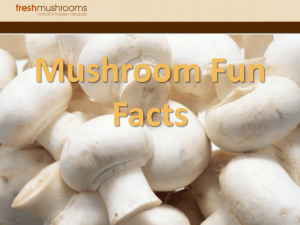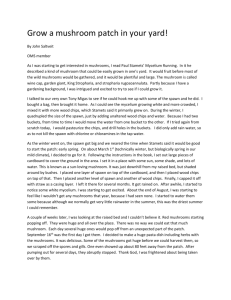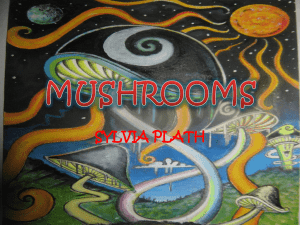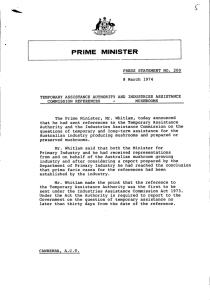Wild Mushrooms: A Brief Introduction to Harvesting and Marketing
advertisement
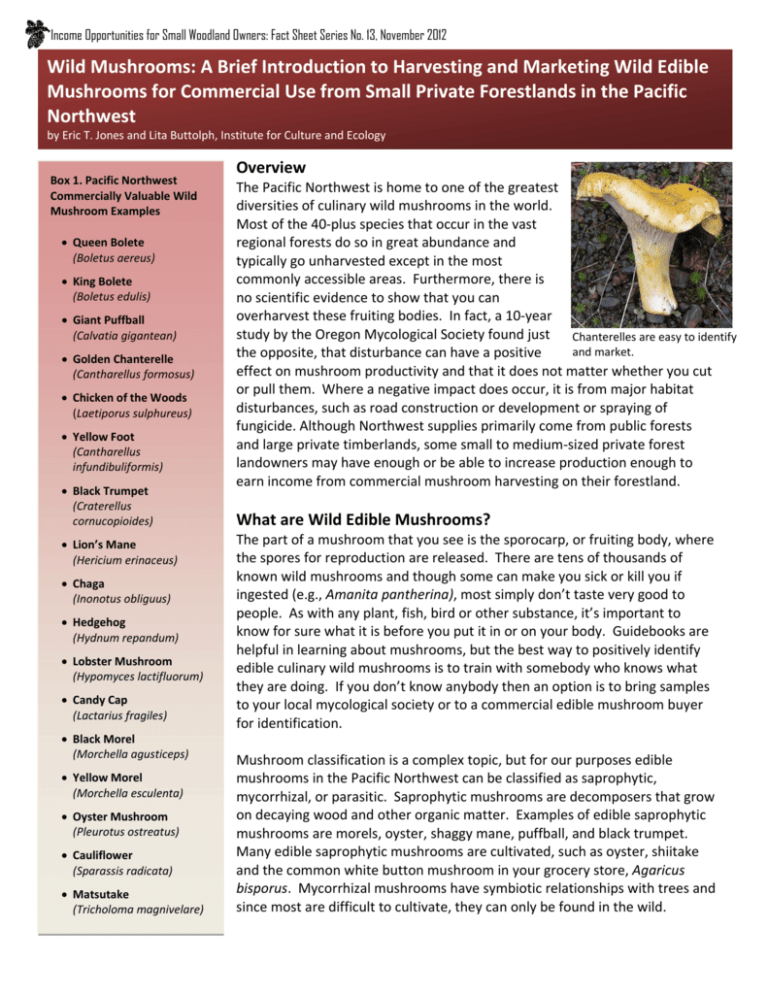
Income Opportunities for Small Woodland Owners: Fact Sheet Series No. 13, November 2012 Wild Mushrooms: A Brief Introduction to Harvesting and Marketing Wild Edible Mushrooms for Commercial Use from Small Private Forestlands in the Pacific Northwest by Eric T. Jones and Lita Buttolph, Institute for Culture and Ecology Box 1. Pacific Northwest Commercially Valuable Wild Mushroom Examples Queen Bolete (Boletus aereus) King Bolete (Boletus edulis) Giant Puffball (Calvatia gigantean) Golden Chanterelle (Cantharellus formosus) Chicken of the Woods (Laetiporus sulphureus) Yellow Foot (Cantharellus infundibuliformis) Black Trumpet (Craterellus cornucopioides) Lion’s Mane (Hericium erinaceus) Chaga (Inonotus obliguus) Hedgehog (Hydnum repandum) Lobster Mushroom (Hypomyces lactifluorum) Candy Cap (Lactarius fragiles) Black Morel (Morchella agusticeps) Yellow Morel (Morchella esculenta) Oyster Mushroom (Pleurotus ostreatus) Cauliflower (Sparassis radicata) Matsutake (Tricholoma magnivelare) Overview The Pacific Northwest is home to one of the greatest diversities of culinary wild mushrooms in the world. Most of the 40‐plus species that occur in the vast regional forests do so in great abundance and typically go unharvested except in the most commonly accessible areas. Furthermore, there is no scientific evidence to show that you can overharvest these fruiting bodies. In fact, a 10‐year study by the Oregon Mycological Society found just Chanterelles are easy to identify and market. the opposite, that disturbance can have a positive effect on mushroom productivity and that it does not matter whether you cut or pull them. Where a negative impact does occur, it is from major habitat disturbances, such as road construction or development or spraying of fungicide. Although Northwest supplies primarily come from public forests and large private timberlands, some small to medium‐sized private forest landowners may have enough or be able to increase production enough to earn income from commercial mushroom harvesting on their forestland. What are Wild Edible Mushrooms? The part of a mushroom that you see is the sporocarp, or fruiting body, where the spores for reproduction are released. There are tens of thousands of known wild mushrooms and though some can make you sick or kill you if ingested (e.g., Amanita pantherina), most simply don’t taste very good to people. As with any plant, fish, bird or other substance, it’s important to know for sure what it is before you put it in or on your body. Guidebooks are helpful in learning about mushrooms, but the best way to positively identify edible culinary wild mushrooms is to train with somebody who knows what they are doing. If you don’t know anybody then an option is to bring samples to your local mycological society or to a commercial edible mushroom buyer for identification. Mushroom classification is a complex topic, but for our purposes edible mushrooms in the Pacific Northwest can be classified as saprophytic, mycorrhizal, or parasitic. Saprophytic mushrooms are decomposers that grow on decaying wood and other organic matter. Examples of edible saprophytic mushrooms are morels, oyster, shaggy mane, puffball, and black trumpet. Many edible saprophytic mushrooms are cultivated, such as oyster, shiitake and the common white button mushroom in your grocery store, Agaricus bisporus. Mycorrhizal mushrooms have symbiotic relationships with trees and since most are difficult to cultivate, they can only be found in the wild. 2 Examples of mycorrhizal mushrooms are chanterelles, king boletes (also known as porcini or ceps), and matsutake or pine mushrooms. Parasitic mushrooms parasitize a host species, such as a tree. Apparently there are few true parasitic mushrooms known and many are closer to saprophytic mushrooms. Examples of parasitic edible mushrooms include lion’s mane and lobster mushroom. Market Potential Although markets for culinary wild mushrooms in Europe and Asian are very old, it wasn’t until the late 1970s that the Pacific Morel mushrooms Northwest saw commercial buyers start to emerge. Initially the mushrooms were shipped to Europe (e.g., porcini) and Asia (e.g., matsutake) and, to a lesser extent, to large U.S. cities. As awareness and demand for gourmet ingredients has spread, it has become common to find chanterelles and other wild mushrooms offered even in mainstream grocery stores such as Safeway. Most of the supply has come from people harvesting on public lands or large private timber company lands and selling to local field buyers or city wholesalers who then ship to other distributors or directly to restaurants and grocery stores. Less common have been commercial wild edible mushrooms supplied from small private forest lands. Many of the edible wild mushrooms for example, chanterelles, hedgehogs, and yellow foot have low wholesale prices, from $1 to 2 a pound, when the season is most productive. Other mushrooms such as matsutake, king bolete, buttons, and black trumpet have higher values but less common habitat than chanterelles. Morels are unique in that there are the naturals that come up in the same place year after year in small quantities, but also ones that fruit abundantly on areas that had a forest fire the previous year. If the conditions such as habitat, moisture, and temperature all come together just right, enormous quantities can be generated for weeks, even months. Few small forest landowners are likely to have an abundance of edible wild mushrooms to supply large commercial buyers. However, where a small landowner can earn some extra income from wild mushrooms is in the niche market. For example, let’s say you found a few cauliflower mushrooms growing on your property, each weighing a couple pounds. A local chef of a fine restaurant might offer you $10 a pound or more for them if they were brought to them in excellent condition on the day of harvest. Other niche markets could include a local gourmet grocery store, a farmers’ market stand, or a small commercial buyer who has local contacts. Steps to Get Started A first step to take is to learn about mushroom habitat. Most commercial edible mushrooms are only visible during their fruiting season, with some exceptions, including chaga. Therefore, to inventory your property you need to wait until the conditions are good and then check weekly, as even under the right conditions there can be a lot of variation in if and when they will appear. In addition to weekly checks you should check several years in a row. Keep a spreadsheet of when and where you check and make notes about the habitat and climatic conditions. This information is simple to collect and will be invaluable for assessing your commercial mushroom production and potential. Even if you decide not to harvest commercially, mushrooms can be an indicator of a healthy, resilient ecosystem and can at least produce something for your own dinner table or for guests or tourists visiting your land. King Bolete 3 Chanterelles being cleaned with an air compressor. When harvesting mushrooms you can use a basket or a bucket with holes drilled in it to let rain water out and to promote air circulation. Cut them from the ground or tree with a knife to keep dirt out of the bucket. You might tape a brush to the end of your knife to quickly brush dirt from the mushroom as you pick. You can also spread them out later and use an air compressor to knock off dirt and needles. Avoid rotting mushrooms, and if they are excessively wet after harvest you can lay them out on a tray in a refrigerator which will wick the excess moisture off them. Keep fresh mushrooms refrigerated. It is best to sell them as soon as possible. Most mushrooms can be dried or canned but most buyers will only buy dried from a reputable source so check ahead before drying. Some mushrooms, such as morels and porcini, reconstitute better than others after being dried and have a good resale value. Additional Resources Arora, David. 1991. All that the Rain Promises. Ten Speed Press. The Role of Mushrooms in Nature. 2012. The Overstory #86. http://agroforestry.net/overstory/overstory86.html Filip, G. 1998. Harvesting and Marketing Edible Wild Mushrooms. Oregon State University Extension. http://hdl.handle.net/1957/14468 Acknowledgements Funding was provided by a grant from USDA National Institute for Food and Agriculture. For more information on nontimber products, including resources for small woodland owners, go to www.ntfpinfo.us.




